Force Health Protection: Nutrition and Exercise Resource Manual
Force Health Protection: Nutrition and Exercise Resource Manual
Force Health Protection: Nutrition and Exercise Resource Manual
Create successful ePaper yourself
Turn your PDF publications into a flip-book with our unique Google optimized e-Paper software.
the Air <strong>Force</strong> Marathon, or similar events,<br />
contact a local running group, a national running<br />
program, or a trainer with experience in<br />
coaching distance runners. Training for these<br />
distance races can be very challenging, both<br />
physically <strong>and</strong> mentally. For more information<br />
on running distance races, contact the American Running <strong>and</strong> Fitness<br />
Association at http://americanrunning.org.<br />
Swimming<br />
Swimming is an excellent exercise for overall<br />
fitness. Because the water supports your body weight, swimming is a great<br />
cross-training exercise for running <strong>and</strong> other gravity-intense activities.<br />
Swimming is also an alternative for people with orthopedic problems or those<br />
who are in rehabilitation.<br />
Beginning a Swim Program<br />
For swimming to be the primary mode of exercise, a swimmer must be<br />
skilled. Unskilled swimmers are very inefficient. To emphasize the energy<br />
expenditure during a swim, swimming 1/4 mile, or 440 meters, is equivalent<br />
to jogging 1 mile. Therefore, it is very likely that an inexperienced swimmer<br />
will not be able to swim continuously for 20 to 30 minutes. Knowing this, if<br />
you are unfamiliar with the basic swimming strokes, focus on your technique<br />
by taking lessons.<br />
If you have never swum, start by walking or jogging<br />
the width of the pool in chest deep water using any<br />
flotation device you want. Once you can complete two to<br />
four, 5-10 minute exercise bouts within your target HR<br />
zone, progress to swimming exercises. Try walking or<br />
jogging the width of the pool <strong>and</strong> swimming back, again<br />
using a flotation device. Gradually decrease the distance<br />
you walk or jog <strong>and</strong> increase the distance you swim until<br />
you can swim four widths without stopping.<br />
Once you have reached this point, begin swimming<br />
the lengths of the pool (1 length = 25 meters; roughly 25<br />
yards). Start by alternating a 25 meter swim with a 30<br />
second rest. Gradually increase the number of lengths you swim without a<br />
rest, until you can swim continuously for 20-30 minutes. Then you will have<br />
a good base for increasing your distance or pace. Table 6-4 outlines a 10-week<br />
swim program for intermediate swimmers.<br />
52 <strong>Force</strong> <strong>Health</strong> <strong>Protection</strong>:




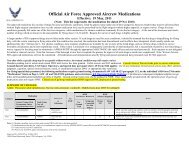
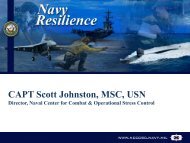
![Body Composition and Military [PDF] - Human Performance ...](https://img.yumpu.com/43269347/1/190x245/body-composition-and-military-pdf-human-performance-.jpg?quality=85)
![Tips for Grocery Shopping [PDF]](https://img.yumpu.com/37447379/1/190x245/tips-for-grocery-shopping-pdf.jpg?quality=85)
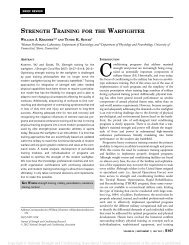
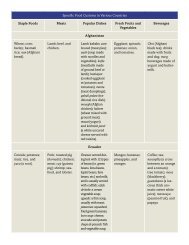
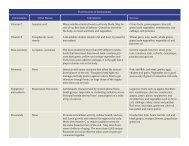
![Synthetic Drugs [PDF] - Human Performance Resource Center](https://img.yumpu.com/37447322/1/190x245/synthetic-drugs-pdf-human-performance-resource-center.jpg?quality=85)


